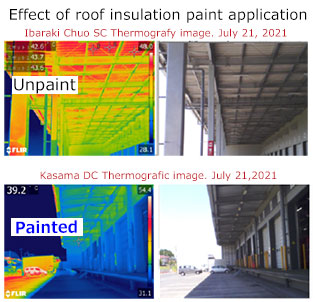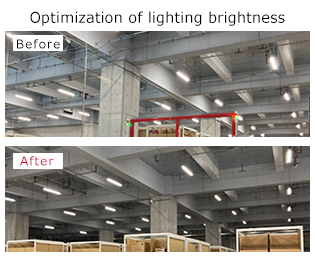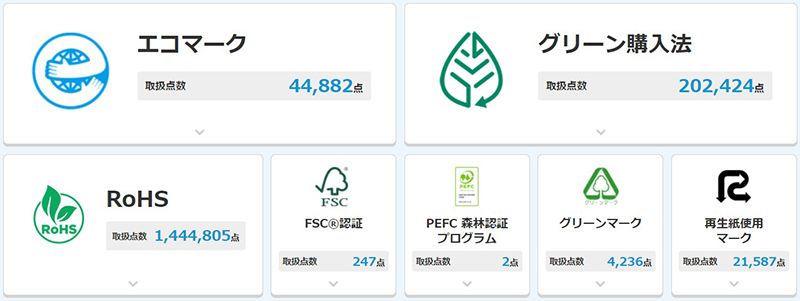Environmental
Reduction of GHG emissions to address climate change
[Reduction Target]
- - Ibaraki Prefecture, Kasama Distribution Center (hereafter referred to as Kasama DC)
- - Ibaraki Prefecture, Ibaraki Central Satellite Center (hereafter referred to as Ibaraki Central SC)
- - Hyogo Prefecture, Inagawa Distribution Center (hereafter referred to as Inagawa DC)
- - Heat-insulating paint was applied to the roof

Heat-insulating paint was applied to the roof of the Kasama DC (2020), and Ibaraki Central SC (2023). This lowered the temperature of areas prone to high temperatures which lead to reduced use of electricity for air conditioning purposes and a better work environment for employees.
*The image compares the roof area of the truck berths of the Ibaraki Central SC before painting and the Kasama DC after painting in July 2021.
- - Reducing lighting brightness

The Inagawa DC utilizes a large number of Auto guided vehicle Robot (AGV) in product storage areas, etc. and human access is restricted for safety reasons in areas where robots carrying shelves come and go. The lighting brightness in this area was equivalent to that of the area where people work. However, the robot area where no people are regularly working is large, and reducing lighting brightness will lead to major energy savings (less electricity consumption).
The Company achieved energy-efficient logistics operations by using LED lighting systems with sensors that enable illumination control via tablets and reduce excess power usage. This system can be used to set lighting brightness and hours of use, acquire hourly usage history data, and set lighting according to individual schedule and group. Prior to implementation, we measured brightness at multiple locations to confirm the impact on safety and workability.
- - Optimized in-house warehouse compressor pressure used for automatic material handling and box sealing equipment, etc. (reduced electricity consumption)
- - As a corporation governed by the Energy Conservation Act, Company started to work by setting a target of reducing energy consumption 1% or more on an annual basis.
- - As a measure to reduce environmental impact through improving transportation efficiency, we launched the “container round use” initiative at our logistics bases in January 2024.
We have switched to substantially renewable energy sources for electricity used at our own properties, through the purchase of non-fossil certificates with tracking information. - Kasama DC and Ibaraki Central SC (As of July 2022) - Inagawa DC (As of June 2023.)
Calculate 2020 and 2023 emissions (Scope 1-3) and complete third-party assurance.
(t-CO₂) |
||||||
| Scope | 2020 | 2021 | 2022 | 2023 | 2024 |
|
Scope1 |
10 |
2 |
15 |
32 |
3 | |
Scope2 |
Market-base | 2,687 |
3,919 |
3,817 |
718 |
1,165 |
| Location-base | 3,107 * |
4,042 * |
6,086 * |
7,015 |
7,232 | |
Total |
Market-base | 2,697 |
3,921 |
3,832 |
750 |
1,168 |
| Location-base | 3,117 * |
4,044 * |
6,101 * |
7,047 |
7,235 | |
* The calculation data is based on MonotaRO Co., Ltd. (Japan), which accounts for about 95% of our group's sales.
* Scope 1 mainly covers direct emissions from fuel consumption at distribution centers,offices and by goods transferring among distribution centers.
* Scope 2 mainly covers emissions from the use of electric power and air-conditioning heat at distribution centers and offices.
* In addition to an increase in shipment volume due to business expansion, electricity usage increased with the start of operations at Ibaraki Central SC in 2021, Inagawa DC Phase 1 in 2022, and Inagawa DC Phase 2 in 2023.
* The use of renewable energy has been applied in Kasama DC and Ibaraki Central SC from July 2022 (changed to a renewable energy plan with tracking). From January 2023, this was also applied in Inagawa DC (by purchasing non-fossil certificates with tracking).
- - Developing senario addressing business risks and opportunities.
- ・CO₂ emissions survey. - Measurement of 2023 emissions for Scope 1,2,3
- - Refinement of Scope 3 Calculation Model
- ・CO₂ emission reduction plan
- - Considering the introduction of renewable energy at the new DC (scheduled to start operation in 2028).
Building a Circular Resource Model through Waste Reduction and Recycling
- ・ Completed survey of total amount of internally generated waste.
- - Identification of measures to improve reduction and recycling of cardboard boxes with high total volume and evaluation of measures in progress.
- ・ Completed ascertaining the total amount of cardboard boxes for shipments delivered to customers.
- ・ Sort recyclable products from industrial waste and promote the switch to valuable materials (recycling).
- ・ Started a trial of using damaged products (such as for copying paper) internally within the company to reduce waste.(As November in 2022)
- - Reducing unnecessary purchases by improving the accuracy of demand forecasts.
- - Avoiding inventory disposal through "Limited Stock Sale" pages.
- - Offering toner collection and product repair services.
Resource Circulation: Waste Emissions and Recycling Rate
Classification |
2023 |
2024 |
||
| Waste Emissions (t) | 1,289 |
1,214 | ||
| General Business Waste Amount (t) | 261 |
235 | ||
| Industrial Waste Amount (t) | 1,028 |
979 | ||
| Final Disposal Amount of Industrial Waste (Incineration/Landfill) (t) | 623 |
489 | ||
| Amount of Valuable Materials (t) | 3,771 |
4,084 | ||
| Total Amount of Valuable Materials and Recycled Materials (t) | 4,176 |
4,575 | ||
| Total Amount of Unnecessary Materials (t) | 5,060 |
5,298 | ||
| Recycling Rate (%) | 82.5% |
86.4% | ||
- ・Improvement in the waste volume calculation process and estimation of the total amount ・Formulate and implement a waste reduction promotion plan.・Formulate and implement a recycling promotion plan. ・Formulate and implement a thorough separation plan.
Development and promotion of environmentally friendly products
- ・ "MonotaRO & SDGs" Special pages for Environmentally Friendly Products (Ecology Products) released.
- ・ Sale of environmentally friendly private brand ("MonotaRO" brand) products.
- - Plain A-flute Cardboard Boxes : This product uses recycled cardboard waste from our warehouses.
- - Medium-Density Fiberboard Using Palm Oil Waste : This board uses PALM LOOP®, a recycled wood board technology developed by Panasonic Housing Solutions Co., Ltd. PALM LOOP® uses oil palm waste as a resource to reduce waste and greenhouse gas emissions, and to prevent deforestation. This helps to promote a circular economy that reduces environmental impact while also contributing to local job creation. We will continue to promote product development. (Note: PALM LOOP® is a registered trademark of Panasonic Holdings Corporation.)
- ・ Investigating information on products manufactured by OEM manufacturers.
- ・ Interviews and questionnaires implementation and analysis conducted with customers regarding procurement of environment-conscious products.


| Environmentally Friendly from Production to Disposal | Carbon Neutral | Restriction of Hazardous Substances | ||
| Eco Mark | Green Procurement | Biomass Plastics | Biomass Mark | RoHS |
| 51,106 items | 448,453 items | 193 items | 1,848 items | 6,113,439 items |
| Waste Reduction and Recycling | Ecosystem Protection | |||
| Green Mark | R Mark | Biodegradable Plastics | FSC(R) | PEFC |
| 10,147 items | 18,611 items | 98 items | 736 items | 16 items |
- * "Eco Mark", "Act on Promoting Green Procurement", "PEFC(Programme for the Endorsement of Forest Certification Scheme)", "Green Mark", "R Mark", "RoHS(Restriction of the Use of Certain Hazardous Substances in Electrical Equipment)"
- ・Investigating information on products manufactured by OEM manufacturers.
- ・Interviews and questionnaires implementation and analysis conducted with customers regarding procurement of environment-conscious products.
- ・Product proposals utilizing third-party certification.
- ・MonotaRO defines criteria for environment-conscious products.
- ・Analysis of usage of product attribute information and additional proposals.
3R (Recycle, Repair, Reuse) Services in Our Business
| Examples of 3R Services for Customers | |
• Battery recycling service and sale of recycled items
• Rentals
|
• Repair and calibration
• Other services
|
Disclosure based on TCFD
1. Introduction
In light of these circumstances, in March 2022 we made disclosures, in line with the recommendations of the Task Force on Climate-related Financial Disclosures (TCFD), on the risks and opportunities that climate change presents for the Company. We will continue to strengthen our initiatives to reduce greenhouse gas emissions and respond to climate change, and seek to contribute to the realization of a sustainable society through our business.
2. Governance
The Sustainability Committee reports regularly to the Board of Directors, the organization overseeing the management, and the committee also receives reports from each TF and discusses issues with them.
For each TF, the head of the department related to each important issue is appointed as its head, and practical leaders are appointed in each TF to promote actual initiatives.
Please refer to "Sustainability Committee"
3. Strategy
Physical Risk
Risk Assessment |
Strategy |
|
| Chronic risk |
||
| Acute risk |
Chronic risk: increase in costs for labor environment improvement measures and management costs for staffing.
As of 2022, we are receiving and shipping products to our customers with the help of more than 2,000 staff members at our distribution facilities. With the rise in average temperatures and the increase in the number of extremely hot days, the cost of labor environment improvement measures, especially in distribution warehouses, is expected to rise as well as the cost of staff management due to increased absenteeism.
- - From 2020 to 2022, the actual cost ratio to sales for hourly-waged workers in our distribution warehouses was between 2.81% and 3.12%. Based on this ratio, if, for example, an additional 10% of staff were to be allocated for increased absenteeism, expenses would increase by 0.28~0.31% of sales.
In the event of an increase in typhoons and other wind and flood damage due to climate change, there is a risk of shutdown of logistics centers and delays in the receipt and delivery of products. However, we have reduced this risk since our main distribution centers are not currently located in areas at risk of flooding.
The Company will seek to reduce risks by sharing knowledge of wind and flood damage and the ensuing facility response while dispersing logistics bases to the Kansai and Kanto regions.
Transition risk
Risk Assessment |
Strategy |
|
| Policy | ||
| Technology | ||
| Market | ||
| Reputation |
- ・Carbon Pricing Mainly in the below 2°C scenario, carbon-pricing schemes such as carbon taxes are expected to be introduced, and there is a risk of incurring additional costs due to carbon-pricing if the Company does not sufficiently advance the conversion of electricity procurement to non-fossil energy sources.
- - The actual ratio of electricity costs to sales for the period from 2020 to 2022 was 0.09~0.15%. If the carbon-pricing system is introduced, the cost may increase by more than 30% in relation to the above electricity costs (the carbon price used in the estimation is 130 USD / t-CO2, the figure that the International Energy Agency (IEA) estimates will be current in 2030, and 1 USD = 135 yen).
Opportunity
Opportunity |
Strategy |
|
| Products and services | ||
| Market | ||
| Resources efficiency |
||
| Energy sources |
We will properly consider customer demand, develop environmentally conscious products, and supply disaster prevention and disaster recovery products in a timely manner.
4. Risk management
Please refer to "Risk management"